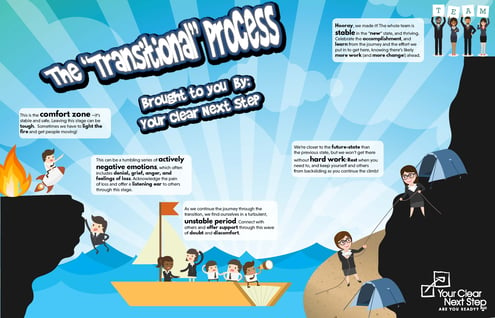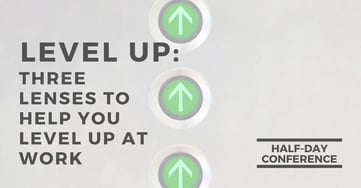Drawing Your Change Journey During the Unknown
If you’ve spent much time with our change management classes or resources, you’ve likely discovered that our framework for leading effective change involves helping others leave behind something that was (“A”) and journey forward to something new (“B”) - something new that is both obviously and urgently better than what we had before. We go through a predictable path from…
- stable in “A” where we are engaged and happy with what was
- to letting go of “A” where we grieve and mourn the loss
- to the “unstable” period where nothing seems solid or firm
- to taking hold of “B” where we work up a sweat.
This is a pretty easy concept to get behind when you’re leading a change you believe in, when it was your brilliant idea, or when the change in an organization comes because the powers that be have set their sights on something greater for us.
But what about when you find yourself in the midst of a change that isn’t being led and doesn’t seem to head towards something better? What if you find yourself changing from something that was familiar to something that is entirely unknown, with no one leading the way? What then?
I’d like to offer a handful of tips addressing that very topic, because so many people that I’m encountering right now are facing just that.
Macro vs Micro
At a macro-level, the world we had back in early 2020 is gone, and we will never go back to the way it was. Now, we’re moving towards something, but what? None of us asked for this; no one was planning for this or dreaming about this, at least not in the circles I’m in. And yet, here it is. Every sector of our lives has changed.
- Education.
- Healthcare.
- Manufacturing and supply chain.
- Communication.
- Technology.
- Government.
- Agriculture.
- Retail.
- The Entertainment Industry.
- The Hospitality Industry.
We are all impacted. The carefully-crafted way things used to work is gone, and we’re headed to, well, what, exactly?
At a more micro-level, maybe you went from a work-in-the-office environment to a hybrid situation with some days at home and some in the office. Maybe you went from a certain set of protocols and routines to something that got you by for the interim, but you’re still not sure what the “go forward” process looks like. Maybe you’ve lost someone you care about. Maybe you or some member of your inner circle has sustained a life-altering injury.
What then? None of these feels like being led through a journey to something obviously better.
So how do we get through?
First things first, give yourself a little grace.
If you are feeling stressed, distressed, uneasy, uncertain about what’s next, uncomfortable, or any other “un” you can think of, give yourself a break. Recognize the discomfort for what it is, and allow yourself to feel what you’re feeling. Change is hard. Letting go of the familiar creates grief and a sense of loss. That’s totally normal. Let yourself grieve the loss of what was so that you can move forward.
Second, know that you are not alone!
You’re in good company. Chances are great that you are not in this discomfort all by yourself. Someone else is either experiencing the same thing alongside you at this very moment, or they’ve been through it sometime in the past. Find a little bit of solace in knowing that someone is as uncomfortable as you are right now, or find a little bit of hope in knowing that someone else has made it through before. Hold onto that. Being off kilter from the changes is bad enough…there’s no need to add loneliness to the mix!
Third, describe where you were clearly enough that you can draw it on a change journey map.
Recognize, out loud if you can, the place you were. Even if you don’t know where you’re going, you likely know where you’ve been, and knowing where you’ve been will help you shape your path forward. Make a list of the characteristics of the situation you left behind - describe the “A” in as much detail as you can. Include things that were good as well as things that were not good. Don’t gloss over the unpleasant stuff with rose-colored glasses, rather be intentional about calling it what it was and being clear and deliberate (and not necessarily positive) about your language. As you draw it, it’s easy enough to think about what you want to have in the new state, but take time to specify what can’t be a part of the new “B” as well as what you don’t want as part of the new “B”.
Fourth, get curious.
Curious about what you want the future to be. Curious of the things you can carry forward to “A” - start listing those in the picture of B. Curious of what else can you add? What might bring you joy? What might bring you hope? What might be fun? What might be valuable in some way? Get curious about what “B” might look like without the things from “A” that simply can’t be there.
Let’s imagine that you’ve decided to repaint your house. The old color included a specific shade of blue mixed with a specific shade of white. When you arrive at the hardware store to have them mix you up a new batch, you learn that one of the two paint colors - the blue - is simply no longer being produced. You can’t have that same blue for mixing again. You can have the white, and there are a couple other blue choices, and a whole bunch of other colors but you can’t have that original mix again. Get curious about what a green house might look like, or a white house, or a cream house, or a gray house. What might be the benefits or opportunities created by having a cream house or a green house, etc.? Get curious about what could be, and start to write it down.
Fifth, find something about “B” to look forward to.
Even the tiniest moment or piece of joy or hope can sometimes be enough to help us take that step forward. Maybe you’ll honor the legacy of the person who is gone by helping someone else in their name - look forward to that. Maybe you’ll have a chance to practice something you’ve been learning - look forward to that. Maybe you’ll have a chance to prove you can learn a new skill - look forward to that. Maybe you’ll have more time to spend with someone than you did in the old “A” - look forward to that. Looking forward to “B” won’t make everything magically all better, but it will give you a reason to step forward.
Sixth, pack for the journey.
Most journeys of change and transition include some steep falls, some unstable valleys, some strenuous climbs. Mentally and emotionally - and maybe even physically - prepare yourself for the journey. Journals to document your progress, resources that offer encouragement, friends who lend a listening ear, others who’ve been there before. Pack the things you’ll need for the trip. Just like you’d pack a cooler full of snacks and beverages or a suitcase full of clothes, set yourself up for success in the transition by packing the things you’ll need for the sunny days, the rainy days, the hard-climbing days, the days when you’d rather not, the days when there’s something to celebrate…you get the idea. If you have a faith foundation that anchors your soul in disrupted times, then turn to the resources of your faith - a Bible, a faith community, hymns and songs that are meaningful, counselors and advisors who share the same foundation, etc., and make sure they are close at hand.
Seventh, and this one is probably the most important, start moving.
We know for sure that what was is gone. But falling off a cliff in grief, treading water in unstable times, and sweating through an uphill climb aren’t places to stay, they are moments to get through. We won’t get to the shore unless we start swimming towards it. Once you’ve acknowledged that what was is gone, start moving, with hope, with curiosity, with purpose, towards something new. They say that large changes take a few course corrections before we find ourselves on the right path - so maybe your first step won’t be quite in the exact direction of all the future steps, but forward, even if a little to the left or a little to the right, is better than no movement at all. You can adjust the sails as you go.
How about you? How do you draw your change journey when “B” isn’t obviously and urgently better?










